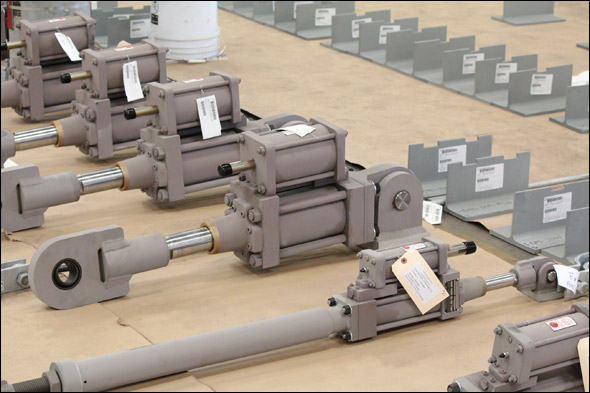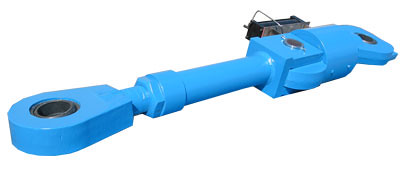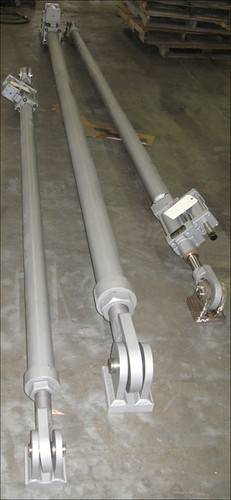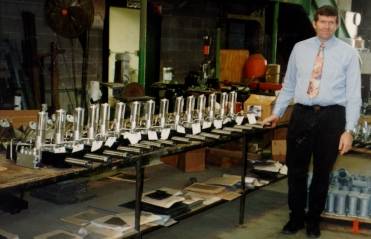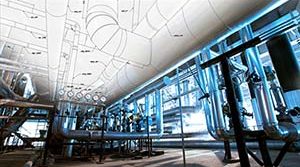Fronek Anchor/Darling, a division of PT&P, designed and manufactured hydraulic snubbers for Geothermal power plants. Historically, these plants are located near tectonic plate boundaries in the Earth’s crust, where thermal activity is easily tapped. This heat energy is transferred into electrical energy through the use of turbines, generators, and heat exchangers. These snubbers are fabricated from stainless steel and include a special paint system suitable for a Hydrogen Sulfide (H2S) environment. All of the snubbers for this application were a 2-1/2 bore size, capable of operating at loads up to 10,000 lb., and were provided with either 6″ or 12″ of available stroke. The Pin-to-Pin dimensions ranged from approximately 36″ to 54″. Each snubber was tested at its rated capacity to ensure acceptable dynamic performance once it was installed in the field.
A hydraulic snubber is used to protect piping from unexpected events, such as water hammers or seismic activity prevalent in geothermal applications, while allowing the piping to move freely during normal operation conditions – a typical movement driven by thermal growth. We have seen hydraulic snubbers used in a large number of different applications, typically during the design phase of a project when the Piping Engineer is designing for a line that may have transient events but must also accommodate thermal growth. A hydraulic snubber works by passing hydraulic fluid between 2 chambers via a poppet valve. When the speed of the fluid passes a threshold, the poppet valve closes and causes the Hydraulic snubber to become rigid support. There is a small relief passage between the two chambers that will eventually allow the Hydraulic snubber to “reset.”
These snubbers were designed and manufactured for one of the world’s leading developers, operators, and manufacturers of geothermal renewable energy. We have long-standing relationships with our clients as a result of our long history and extensive portfolio of products and services. In this case, we supported this client’s initiatives for over 20 years worldwide with their projects in Nevada, California, Oregon, Israel, Hawaii, and Guatemala. In addition to hydraulic snubbers, we provided constant assemblies, pipe shoes, guides, anchors, pipe hanger hardware, slide-bearing plates, and variable spring supports.
PT&P REF. ORIGINAL POST 03232021



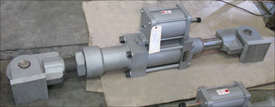
 Similarly to hydraulic snubbers, mechanical snubbers use a telescoping cylinder to permit free movement of the pipe under normal operating conditions. When the threshold acceleration of 0.02 g’s is exceeded, an internal mechanism of the snubber activates, thereby locking the telescoping cylinder and subsequently producing our restraint force.
Similarly to hydraulic snubbers, mechanical snubbers use a telescoping cylinder to permit free movement of the pipe under normal operating conditions. When the threshold acceleration of 0.02 g’s is exceeded, an internal mechanism of the snubber activates, thereby locking the telescoping cylinder and subsequently producing our restraint force. position during either compression or extension modes. However, hydraulic snubbers may show some variation in their dynamic response depending upon the piston location. Therefore, when choosing a hydraulic snubber for a piping system, one must carefully determine the amount of stroke needed to adequately position the snubber piston orientation for optimum functionality.
position during either compression or extension modes. However, hydraulic snubbers may show some variation in their dynamic response depending upon the piston location. Therefore, when choosing a hydraulic snubber for a piping system, one must carefully determine the amount of stroke needed to adequately position the snubber piston orientation for optimum functionality.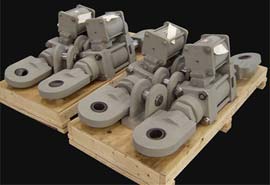
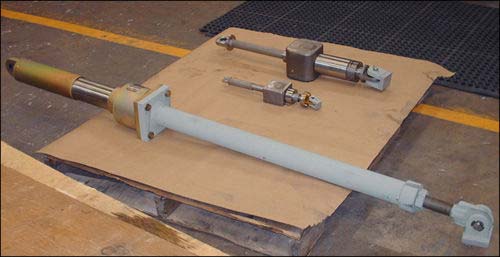
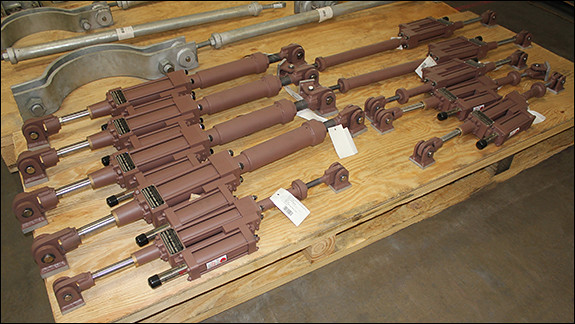
 Explore the various applications of snubbers, sway braces and sway struts in piping systems and equipment. Learn how these products help prevent pipe system failure due to seismic loads, flow transients, wind loads, safety valve thrust loads or pipe rupture. Discover the various tests performed within PT&P’s facility to ensure product quality, including cycle testing, travel testing and load testing. Finally, view the value-added services offered by PT&P and rest assure that your shock control, restraint and support device needs can be covered by our 24×7 web-based emergency services, field services and quick-turn around time when you need it most.
Explore the various applications of snubbers, sway braces and sway struts in piping systems and equipment. Learn how these products help prevent pipe system failure due to seismic loads, flow transients, wind loads, safety valve thrust loads or pipe rupture. Discover the various tests performed within PT&P’s facility to ensure product quality, including cycle testing, travel testing and load testing. Finally, view the value-added services offered by PT&P and rest assure that your shock control, restraint and support device needs can be covered by our 24×7 web-based emergency services, field services and quick-turn around time when you need it most.
